Nanoparticles for Protection of Cells from Oxidative Stress
- Summary
- Abstract
- Description
- Claims
- Application Information
AI Technical Summary
Benefits of technology
Problems solved by technology
Method used
Image
Examples
example 1
Synthesis of Cerium Oxide Nanoparticles
[0088]CeO2 nanoparticles with a particle size of 2-3 nm have been synthesized previously using the reverse micelle method. However, the surfactant sodium bis(2-ethylhexyl) sulphosuccinate (AOT) was used (see, for example, J. Phys.: Condens. Matter, 2001, 13:5269-5283). To improve biocompatibility and reduce potential toxicity of residual surfactant, a bio-surfactant phosphatidylcholine (i.e., soy bean lecithin) was used to form reverse micelles during synthesis. Phosphatidylcholine naturally occurs in cell membranes. Therefore, phosphatidylcholine for reverse micelle formation is expected to reduce the impact of residual surfactants to cell cultures and transplants and the patient. However, large amounts of lecithin have proven detrimental to the success and therefore more than 90% is removed in washing steps. The washing removes both toluene and the lecithin. Furthermore, the as synthesized nanoparticles require colloidal stabilization after r...
example 2
Cellular Uptake of Cerium Oxide Nanoparticles and Reduction of Oxidative Stress
[0092]The inventors have developed several types of nanoparticles, nanoparticle coatings for cell uptake, a method for making these nanoparticles, and have tested them successfully with human islets of Langerhans as well as other mammalian cell lines.
[0093]The present invention pertains to the application of these nanoparticles to diminish oxidative stresses by catalyzing free radicals. This process can take place both intracellularly, and thus benefit the viability and function of the cells, and in solution and thus can be used for a wide variety of industrial applications.
[0094]The data disclosed herein clearly show a reduction in intracellular free radical concentration when these nanoparticles were provided as a supplement to standard culture media.
[0095]The nanoparticles were cerium oxide or cerium oxide-based materials, and are under 20 nm in size. These nanoparticles are well dispersed in solution,...
example 3
Scavenging Role of Ceria Nanoparticles in Murine Islets
[0114]Further studies focus on the findings that certain nanoparticles (cerium oxide) dramatically increased the longevity of neuronal cells in vitro.
[0115]Materials and Methods
[0116]Ceria Nanoparticles. The ceria nanoparticles have and will continue to be engineered by a microemulsion method that ensures monodisperse nanoparticles with control in diameter ranging from 1-100 nm. The inventors will synthesize two sets of particle sizes 1-5 nm and 10-20 nm [10]. Each set will be treated at three different temperatures to control the stoichiometry (Ce3+ / Ce4+ ratio) of the ceria nanoparticles [11]. The particles will be characterized with high resolution (0.014 nm) scanning transmission electron microscopy with elemental contrast (STEM-z) for size and electronic properties (selected area diffraction (SAD) and light scattering techniques for their ensemble properties, as well as Fourier Transform Infrared Spectroscopy (FTIR) and zeta...
PUM
 Login to View More
Login to View More Abstract
Description
Claims
Application Information
 Login to View More
Login to View More - R&D
- Intellectual Property
- Life Sciences
- Materials
- Tech Scout
- Unparalleled Data Quality
- Higher Quality Content
- 60% Fewer Hallucinations
Browse by: Latest US Patents, China's latest patents, Technical Efficacy Thesaurus, Application Domain, Technology Topic, Popular Technical Reports.
© 2025 PatSnap. All rights reserved.Legal|Privacy policy|Modern Slavery Act Transparency Statement|Sitemap|About US| Contact US: help@patsnap.com



